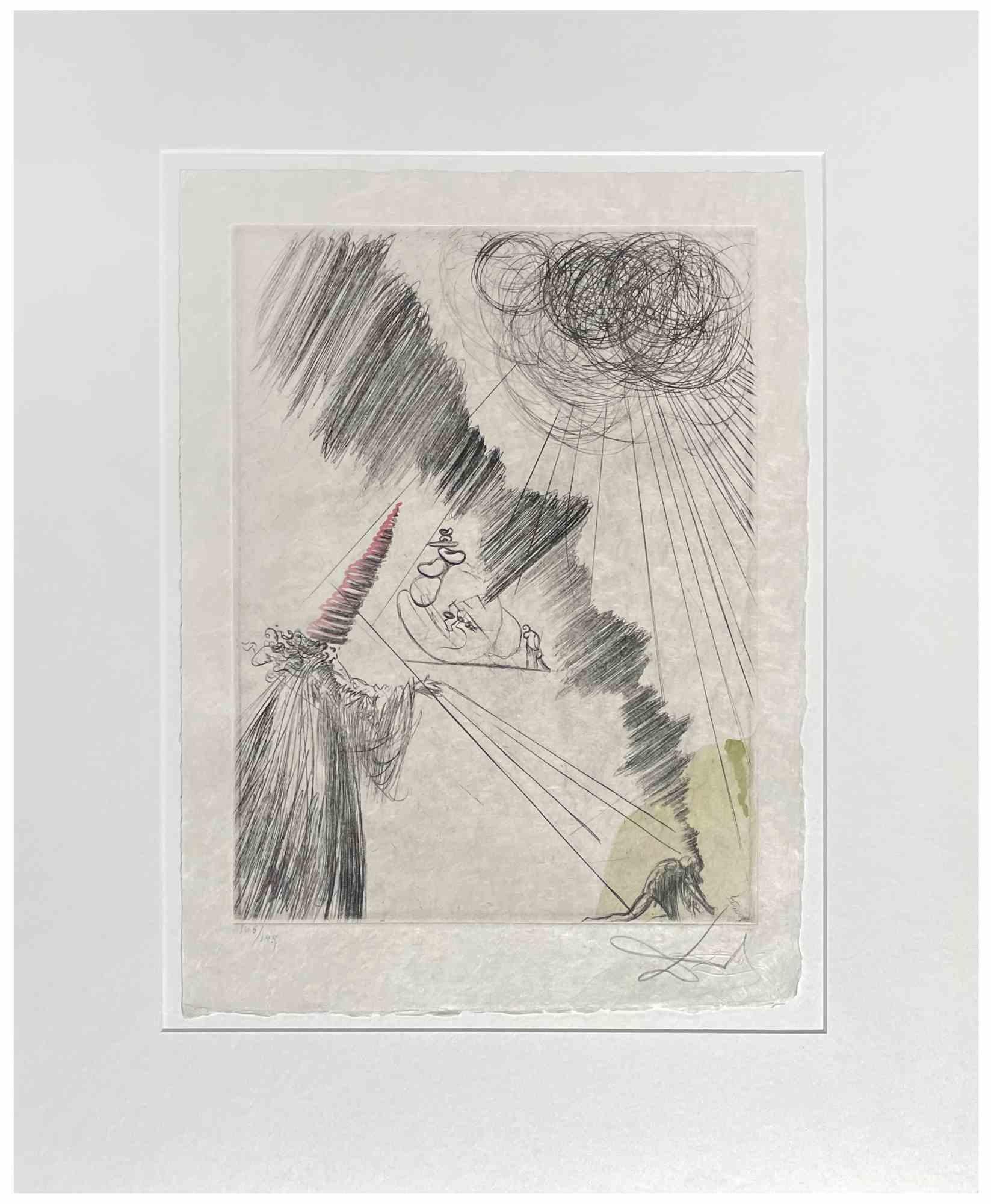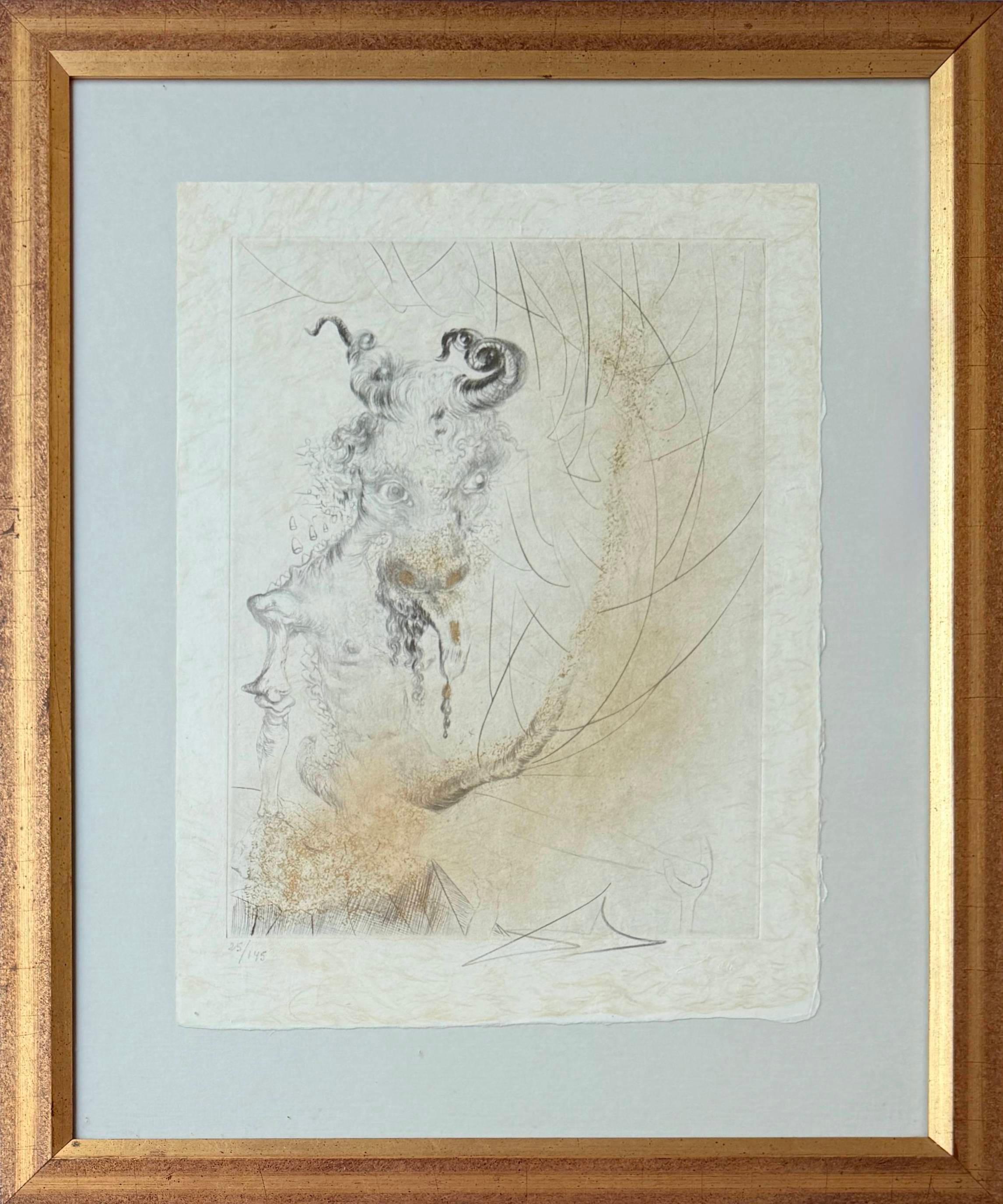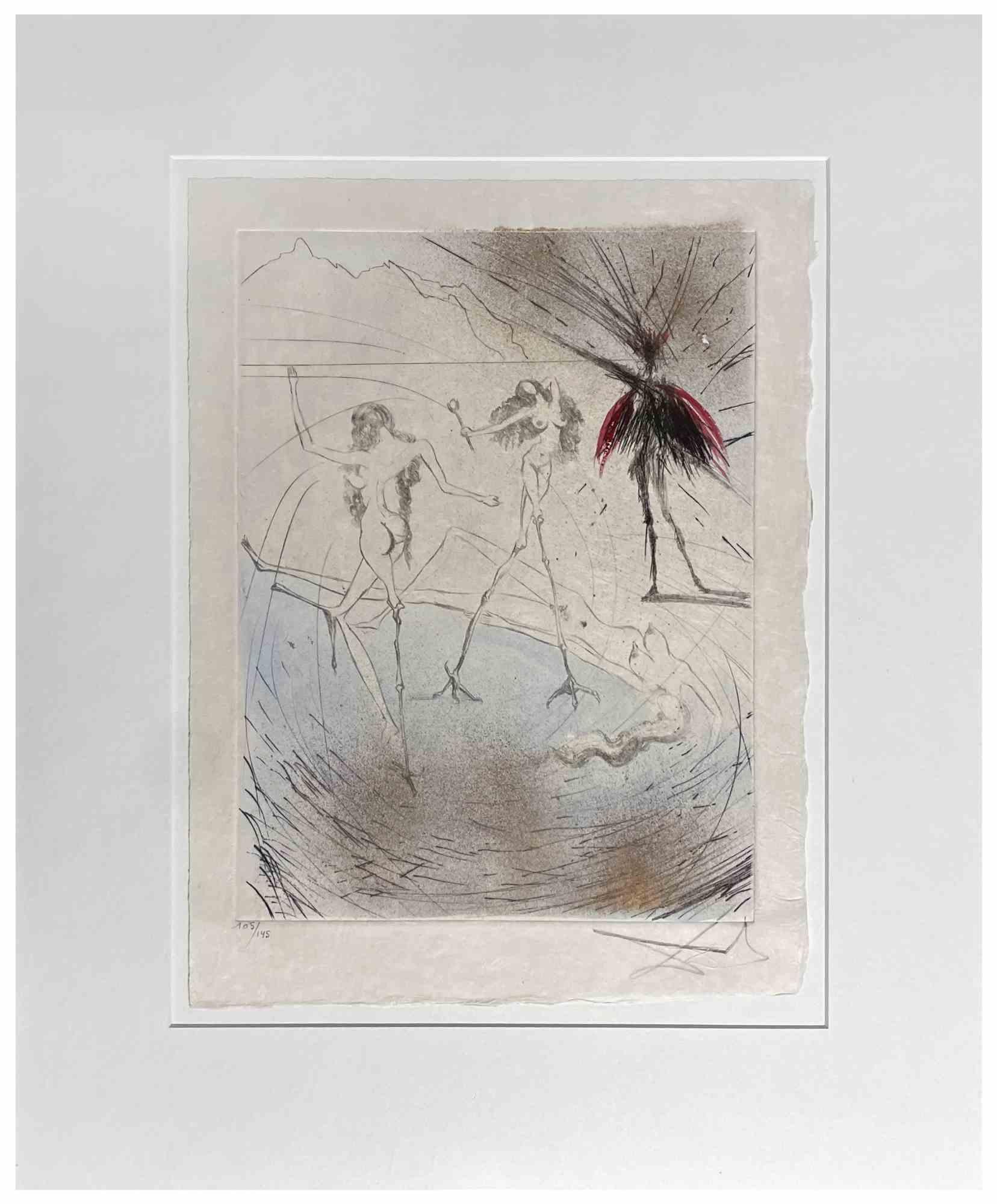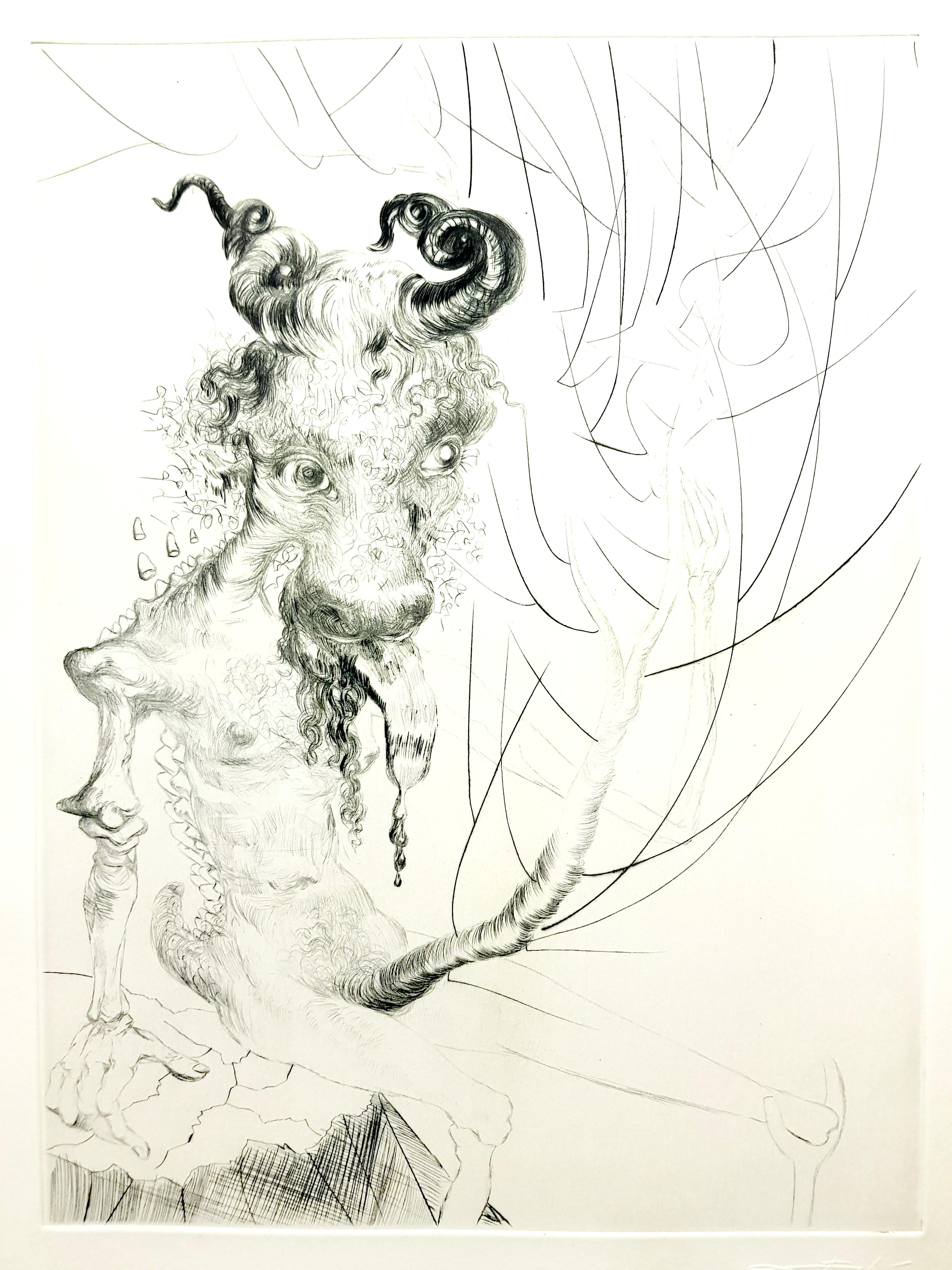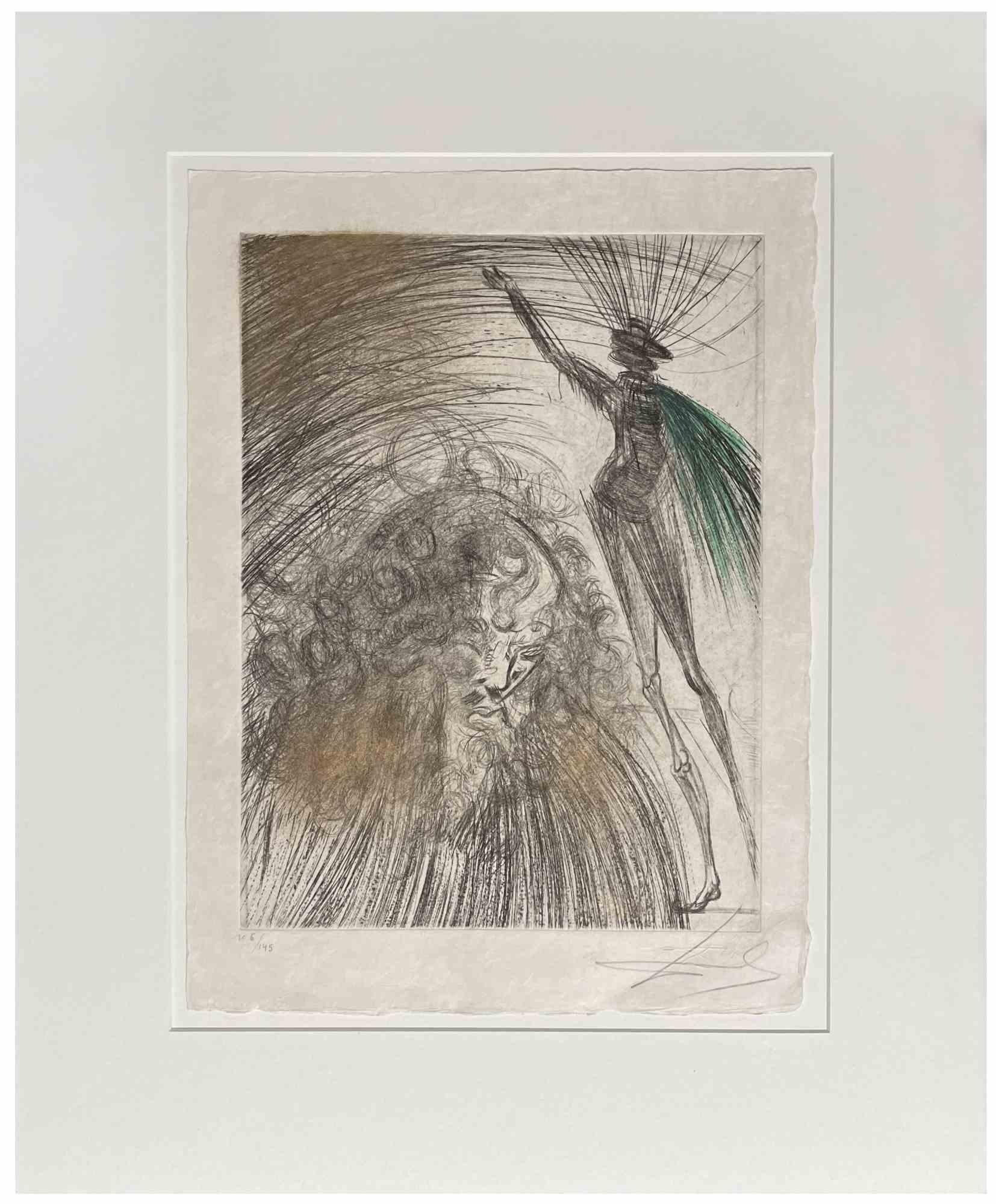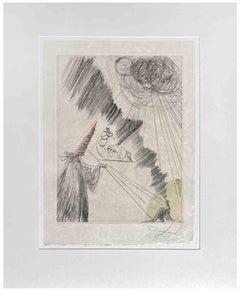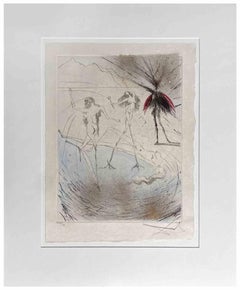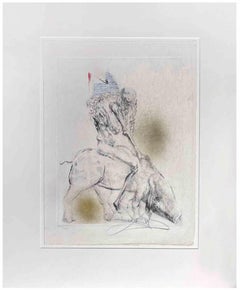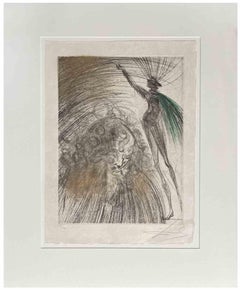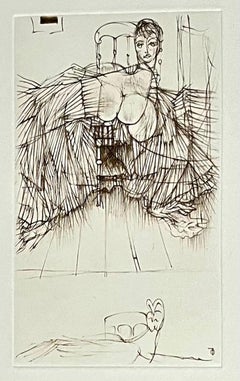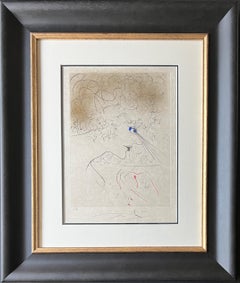Items Similar to Tete de Veau (Calf's Head) - Etching - 1960s
Want more images or videos?
Request additional images or videos from the seller
1 of 5
Tete de Veau (Calf's Head) - Etching - 1960s1960s
1960s
$2,649.21
£1,960.08
€2,200
CA$3,663
A$4,021.52
CHF 2,098.04
MX$48,666.01
NOK 26,295.63
SEK 24,777.40
DKK 16,750.86
About the Item
Tete de Veau (Calf's Head) is an artwork realized in 1968/69, from the Series "Faust" (La Nuit de Walpurgis).
Etching, Drypoint, Watercolor and Roulette on Japon Paper.
Hand signed and numbered. Edition of 105/145.
Printed and published by Robbe.
Ref. Michler-Lopsinger, no. 306.
Sheet 38,5 x 28 xcm; Image 31,8 x 23,9 cm.
It includes passepartout.
Vey good condition.
- Attributed to:Salvador Dalí (1904 - 1989, Spanish)
- Creation Year:1960s
- Dimensions:Height: 15.16 in (38.5 cm)Width: 11.03 in (28 cm)Depth: 0.04 in (1 mm)
- Medium:
- Movement & Style:
- Period:
- Framing:Framing Options Available
- Condition:Insurance may be requested by customers as additional service, contact us for more information.
- Gallery Location:Roma, IT
- Reference Number:Seller: T-1426241stDibs: LU650313174442
About the Seller
4.9
Platinum Seller
Premium sellers with a 4.7+ rating and 24-hour response times
1stDibs seller since 2017
7,709 sales on 1stDibs
Typical response time: 2 hours
- ShippingRetrieving quote...Shipping from: Grasse, France
- Return Policy
Authenticity Guarantee
In the unlikely event there’s an issue with an item’s authenticity, contact us within 1 year for a full refund. DetailsMoney-Back Guarantee
If your item is not as described, is damaged in transit, or does not arrive, contact us within 7 days for a full refund. Details24-Hour Cancellation
You have a 24-hour grace period in which to reconsider your purchase, with no questions asked.Vetted Professional Sellers
Our world-class sellers must adhere to strict standards for service and quality, maintaining the integrity of our listings.Price-Match Guarantee
If you find that a seller listed the same item for a lower price elsewhere, we’ll match it.Trusted Global Delivery
Our best-in-class carrier network provides specialized shipping options worldwide, including custom delivery.More From This Seller
View AllVieux Faust - Etching - 1960s
By Salvador Dalí
Located in Roma, IT
Femme au Clown (Woman with Clown) is an artwork belonging to the Series "Faust" (La Nuit de Walpurgis), and realized in 1968/69.
Etching, Drypoint, Watercolor and Roulette on Japon ...
Category
1960s Surrealist Figurative Prints
Materials
Paper, Watercolor, Drypoint, Etching
Femmes Poules (Hen Woman) - Etching - 1960s
By Salvador Dalí
Located in Roma, IT
Femmes Poules (Hen Woman) is an artwork realized in 1968/69, from the Series "Faust" (La Nuit de Walpurgis).
Etching, Drypoint, Watercolor and Roulette on Japon Paper.
Hand signed ...
Category
1960s Surrealist Figurative Prints
Materials
Etching, Paper, Watercolor, Drypoint
Femme au Cochon (Woman with Pig) - Etching - 1968
By Salvador Dalí
Located in Roma, IT
Femme au cochon (Woman with Pig) is an artwork from the Series "Faust" (La Nuit de Walpurgis), realized in 1968/69.
Etching, Drypoint, Watercolor and Roulette on Japon Paper.
Hand...
Category
1960s Surrealist Figurative Prints
Materials
Etching
Vieux Faust (Old Faust) - Etching - 1960s
By Salvador Dalí
Located in Roma, IT
Vieux Faust (Old Faust) is an artwork realized in 1968/69, from the Series "Faust" (La Nuit de Walpurgis).
Etching, Drypoint, Watercolor and Roulette on Japon Paper, Hand signed an...
Category
1960s Surrealist Figurative Prints
Materials
Paper, Watercolor, Drypoint, Etching
Sorcière au Balai - Etching - 1968
By Salvador Dalí
Located in Roma, IT
Sorcière au Balai is a rare artwork from the Series "Faust" (La Nuit de Walpurgis), realized 1968/69.
Etching, Drypoint, Watercolor and Roulette on Japon...
Category
1960s Surrealist Figurative Prints
Materials
Etching
Bicéphale - Etching - 1968
By Salvador Dalí
Located in Roma, IT
Etching and drypoint realized by Salvador Dalì to illustrate Pierre Ronsard's "Les Amours de Cassandre".
Published by Argillet, Paris, in 1968.
Edition of 299 pieces. One of 165 sp...
Category
1960s Surrealist Figurative Prints
Materials
Etching
You May Also Like
Tete de Veau (Calf's Head)
By Salvador Dalí
Located in OPOLE, PL
Salvador Dali (1904-1989) - Tete de Veau (Calf's Head)
Drypoint etching and watercolor from 1968.
The edition 25/145.
Dimensions of work: 38.5 x 28.5 cm.
Hand signed.
The work i...
Category
1960s Modern More Prints
Materials
Drypoint, Etching
Salvador Dali - Head of Veal - Original Etching
By Salvador Dalí
Located in Collonge Bellerive, Geneve, CH
Salvador Dali - Head of Veal - Original Etching
Embossed signature
From the edition of 731
Dimensions: 38,5 x 28,5 cm
1969
References : Field 69-1 / Michler & Lopsinger 305
Category
1960s Surrealist Nude Prints
Materials
Etching
German Surrealist Hans Bellmer Etching Engraving Print Cecile Reims Surrealism
By Hans Bellmer
Located in Surfside, FL
After Hans Bellmer (German, 1902-1975)
Surrealist engraving, etching
after drawings from a 1942 notebook,
engraved in 1974-75 by Cecile Reims
Printed by L'Atelier de Chalcographie du Louvre, Paris,
Having printed monogram lower left in plate, pencil notations verso Editioned from a very small edition of #7/10 and 'Musee du Louvre' blindstamp.
Dimensions: Sheet 11 X 7.5, Plate size 6.5 X 4
Hans Bellmer ( 1902 – 1975) was a Polish born German artist, best known for his drawings, etchings that illustrates the 1940 edition of Histoire de l’œil, and the life-sized female sculpture mannequin dolls he produced in the mid-1930s. Historians of art and photography also consider him a Surrealist photographer.
Bellmer was born in the city of Kattowitz, then part of the German Empire (now Katowice, Poland). Up until 1926, he worked as a draftsman for his own advertising company.
Bellmer is most famous for the creation of a series of dolls as well as photographs of them. He was influenced in his choice of art form in part by reading the published letters of Oskar Kokoschka (Der Fetisch, 1925) and Surrealism. Bellmer's puppet doll project is also said to have been catalysed by a series of events in his personal life.
Hans Bellmer takes credit for provoking a physical crisis in his father and brings his own artistic creativity into association with childhood insubordination and resentment toward a severe and humorless paternal authority. Perhaps this is one reason for the nearly universal, unquestioning acceptance in the literature of Bellmer's promotion of his art as a struggle against his father, the police, and ultimately, fascism and the state. Events of his personal life also including meeting a beautiful teenage cousin in 1932 (and perhaps other unattainable beauties), attending a performance of Jacques Offenbach's Tales of Hoffmann (in which a man falls tragically in love with an automaton), and receiving a box of his old toys. After these events, he began to actually construct his first dolls. In his works, Bellmer explicitly sexualized the doll as a young girl (his work bears connection to the works of Bathus). Hirschfeld has claimed (without further argumentation) that Bellmer initiated his doll project to oppose the fascism of the Nazi Party by declaring that he would make no work that would support the new German state. Represented by mutated forms and unconventional poses, his dolls (according to this view) were directed specifically at the cult of the perfect body then prominent in Germany.
He visited Paris in 1935 and made contacts there, such as Paul Éluard, but returned to Berlin because his wife Margarete was dying of tuberculosis. He was part of the circle of Surrealist luminaries such as Man Ray, Marcel Duchamp, Max Ernst, Joan Miro, André Masson, René Magritte, Alberto Giacometti and Salvador Dali as well as women artists—such as Frida Kahlo, Dorothea Tanning and Leonora Carrington.
Bellmer produced the first doll in Berlin in 1933. Long since lost, the assemblage can nevertheless be correctly described thanks to approximately two dozen photographs Bellmer took at the time of its construction. Standing about fifty-six inches tall, the doll consisted of a modeled torso made of flax fiber, glue, and plaster; a mask-like head of the same material with glass eyes and a long, unkempt wig; and a pair of legs made from broomsticks or dowel rods. One of these legs terminated in a wooden, club-like foot; the other was encased in a more naturalistic plaster shell, jointed at the knee and ankle. As the project progressed, Bellmer made a second set of hollow plaster legs, with wooden ball joints for the doll's hips and knees. There were no arms to the first sculpture, but Bellmer did fashion or find a single wooden hand, which appears among the assortment of doll parts the artist documented in an untitled photograph of 1934, as well as in several photographs of later work.
Bellmer's 1934 anonymous book, The Doll (Die Puppe), produced and published privately in Germany, contains 10 black-and-white photographs of Bellmer's first doll arranged in a series of "tableaux vivants" (living pictures). The book was not credited to him, as he worked in isolation, and his photographs remained almost unknown in Germany. Yet Bellmer's work was eventually declared "degenerate" (entartete kunst) by the Nazi Party, and he was forced to flee Germany to France in 1938, where Bellmer's work was welcomed by the Surrealists around Andre Breton.
He aided the French Resistance during the war by making fake passports. He was imprisoned in the Camp des Milles prison at Aix-en-Provence, a brickworks camp for German nationals, from September 1939 until the end of the Phoney War in May 1940.
After the war, Bellmer lived the rest of his life in Paris. Bellmer gave up doll-making and spent the following decades creating erotic drawings, etchings, sexually explicit photographs, paintings, and prints of pubescent girls. In 1954, he met Unica Zürn...
Category
20th Century Abstract Prints
Materials
Etching
Salvador Dalí – La Tête ( The Head ) – hand watercolored drypoint etching – 1969
By Salvador Dalí
Located in Varese, IT
hand watercolored drypoint etching on extremely fine Japanese paper, edited in 1969
limited edition of 145 copies water-colored
, numbered in lower left corner ea ( artist proof )
signed in pencil by artist in lower right corner
paper size: 38.5 x 28.5 cm
framed size: 65 x 55 cm
very good conditions
Bibliography:
Salvador Dalí Catalogue Raisoneé of etchings and mixed media prints Ref 369 pag 178
Fast and Tracked shipping with express currier DHL .
We offer professional packaging and tracked shipping with DHL Express courier
( shipping time: 24 hours for European countries and 4 to 6 days for America and other non-eu countries...
Category
1960s Surrealist Prints and Multiples
Materials
Paper, Watercolor, Drypoint, Etching
German Surrealist Hans Bellmer Etching Engraving Print Cecile Reims Surrealism
By Hans Bellmer
Located in Surfside, FL
After Hans Bellmer (German, 1902-1975)
Surrealist engraving, etching
after drawings from a 1942 notebook,
engraved in 1974-75 by Cecile Reims
Printed by L'Atelier de Chalcographie du Louvre, Paris,
Having printed monogram lower left in plate, pencil notations verso Editioned from a very small edition of #7/10
'Musee du Louvre' blindstamp.
Dimensions: Sheet 11 X 7.5, Plate size 6.5 X 4
Hans Bellmer ( 1902 – 1975) was a Polish born German artist, best known for his drawings, etchings that illustrates the 1940 edition of Histoire de l’œil, and the life-sized female sculpture mannequin dolls he produced in the mid-1930s. Historians of art and photography also consider him a Surrealist photographer.
Bellmer was born in the city of Kattowitz, then part of the German Empire (now Katowice, Poland). Up until 1926, he worked as a draftsman for his own advertising company.
Bellmer is most famous for the creation of a series of dolls as well as photographs of them. He was influenced in his choice of art form in part by reading the published letters of Oskar Kokoschka (Der Fetisch, 1925) and Surrealism. Bellmer's puppet doll project is also said to have been catalysed by a series of events in his personal life.
Hans Bellmer takes credit for provoking a physical crisis in his father and brings his own artistic creativity into association with childhood insubordination and resentment toward a severe and humorless paternal authority. Perhaps this is one reason for the nearly universal, unquestioning acceptance in the literature of Bellmer's promotion of his art as a struggle against his father, the police, and ultimately, fascism and the state. Events of his personal life also including meeting a beautiful teenage cousin in 1932 (and perhaps other unattainable beauties), attending a performance of Jacques Offenbach's Tales of Hoffmann (in which a man falls tragically in love with an automaton), and receiving a box of his old toys. After these events, he began to actually construct his first dolls. In his works, Bellmer explicitly sexualized the doll as a young girl (his work bears connection to the works of Bathus). Hirschfeld has claimed (without further argumentation) that Bellmer initiated his doll project to oppose the fascism of the Nazi Party by declaring that he would make no work that would support the new German state. Represented by mutated forms and unconventional poses, his dolls (according to this view) were directed specifically at the cult of the perfect body then prominent in Germany.
He visited Paris in 1935 and made contacts there, such as Paul Éluard, but returned to Berlin because his wife Margarete was dying of tuberculosis. He was part of the circle of Surrealist luminaries such as Man Ray, Marcel Duchamp, Max Ernst, Joan Miro, André Masson, René Magritte, Alberto Giacometti and Salvador Dali as well as women artists—such as Frida Kahlo, Dorothea Tanning and Leonora Carrington.
Bellmer produced the first doll in Berlin in 1933. Long since lost, the assemblage can nevertheless be correctly described thanks to approximately two dozen photographs Bellmer took at the time of its construction. Standing about fifty-six inches tall, the doll consisted of a modeled torso made of flax fiber, glue, and plaster; a mask-like head of the same material with glass eyes and a long, unkempt wig; and a pair of legs made from broomsticks or dowel rods. One of these legs terminated in a wooden, club-like foot; the other was encased in a more naturalistic plaster shell, jointed at the knee and ankle. As the project progressed, Bellmer made a second set of hollow plaster legs, with wooden ball joints for the doll's hips and knees. There were no arms to the first sculpture, but Bellmer did fashion or find a single wooden hand, which appears among the assortment of doll parts the artist documented in an untitled photograph of 1934, as well as in several photographs of later work.
Bellmer's 1934 anonymous book, The Doll (Die Puppe), produced and published privately in Germany, contains 10 black-and-white photographs of Bellmer's first doll arranged in a series of "tableaux vivants" (living pictures). The book was not credited to him, as he worked in isolation, and his photographs remained almost unknown in Germany. Yet Bellmer's work was eventually declared "degenerate" (entartete kunst) by the Nazi Party, and he was forced to flee Germany to France in 1938, where Bellmer's work was welcomed by the Surrealists around Andre Breton.
He aided the French Resistance during the war by making fake passports. He was imprisoned in the Camp des Milles prison at Aix-en-Provence, a brickworks camp for German nationals, from September 1939 until the end of the Phoney War in May 1940.
After the war, Bellmer lived the rest of his life in Paris. Bellmer gave up doll-making and spent the following decades creating erotic drawings, etchings, sexually explicit photographs, paintings, and prints of pubescent girls. In 1954, he met Unica Zürn...
Category
20th Century Abstract Prints
Materials
Etching
"Rabbit" - 1976 Surrealist Lithograph on Paper
Located in Soquel, CA
"Rabbit" - 1976 Surrealist Lithograph on Paper
1976 surrealist lithograph on paper titled "Rabbit" by Jim Crabb (American, b. 1947). This piece resembles a surreal landscape, with b...
Category
1970s Surrealist Figurative Prints
Materials
Ink, Laid Paper, Lithograph
$480 Sale Price
20% Off
More Ways To Browse
Salvador Dali Head
Jacques Soisson
Jean Jansem On Sale
Jim Dine Pinocchio
Jim Dine Robe Print
Judge Portrait
Keith Haring Free South Africa
Keith Haring Signed Lithograph
La Conquete Du Cosmos
Le Fumeur
Lithograph Yrjo Edelmann
Madeline Prints
Man In Bowler Hat
Marc Chagall 1975
Marc Chagall Daphnis
Marc Chagall Fleurs
Marc Chagall Hand Signed
Marc Chagall Paris Opera
